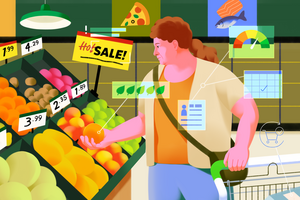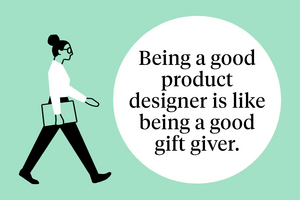Marketing Feb 1, 2008
Predicting Customer Lifetime Value
When is it sensible to give perks to customers?
“Prediction is very difficult, especially about the future.”
While Nobel Laureate physicist Niels Bohr probably had subatomic, quantum mechanical phenomena in mind when he made that statement, the same could be said for customer behaviors. Or so thought Robert Blattberg, Professor of Marketing at the Kellogg School of Management, and Edward Malthouse, Associate Professor of Integrated Marketing Communications at Northwestern’s Medill School of Journalism, in their Journal of Interactive Marketing paper describing the surprising uncertainty inherent in differentially marketing to customers based upon their past performance.
As Blattberg put it, “There’s just more serendipity in behavior.”
For their efforts to better understand long-term customer behavior and value, Malthouse and Blattberg were awarded the journal’s “Best Paper of 2005.”
“Ultimately, I’m interested in drivers of long-term customer behavior,” said Blattberg, the Polk Brothers Distinguished Professor of Retailing, and Director of the Center for Retail Management. “I study this by looking at sales databases, not by studying it in a lab.”
Marketers attempt to pinpoint the best customers with the help of tools such as RFM analysis.
Malthouse and Blattberg are especially interested in behavior that determines customers’ long-term value—that is, the expected benefits to a company after taking into account the expected costs of maintaining a relationship with a customer over an extended period of time. A valuable relationship, like any other company asset, merits proper investment and management. Many companies divert significant attention and resources to marketing techniques that seek to cultivate loyalty among the perceived best customers.
“Companies are focused on rewarding the best customers, because they think they’ll continue to be the best customers,” said Blattberg.
If you have been a great customer, catalog companies may send you more mailings, airlines may give you priority for upgrades, credit card companies may waive late fees, and hotels may leave a bottle of cabernet in your suite. These are discretionary marketing investments, bestowed upon unsuspecting customers and intended to cultivate continued, profitable business among the best customers. At the heart of this practice lies the belief that a good customer yesterday will be a good customer tomorrow.
But is it possible to predict which customers will be best over the long haul, and to do so reliably enough to justify giving them the white glove, five-star treatment? Malthouse and Blattberg set out to answer these questions. Said Blattberg, “This paper focused on whether past best customers remain future best customers: Are past heavy users of X future heavy users of X?”
Marketers attempt to pinpoint the best customers with the help of tools such as RFM analysis. This technique measures how recently customers made purchases (R, recency), how often they made purchases (F, frequency), and how much they spent (M, monetary value). If the axiom stating that “80 percent of your business comes from 20 percent of your customers” is true, then RFM analysis can help identify who the best 20 percent of customers have been. But does it allow companies to predict whether the top 20 percent from the past will bring long-term advantage in the future?
“The literature on customer databases focused on RFM analysis looks at customers’ propensity to make their very next purchase,” said Blattberg. “But it doesn’t automatically follow that they’ll continue as best customers over the long term.”
To measure and attempt to predict customers’ long-term value, Malthouse and Blattberg evaluated reams of sales data collected by various companies over many years. The scope of their data was immense. They studied over 136,000 donors to a not-for-profit organization during a two-year period, over 71,000 customers of a service provider during a five-year span, over 41,000 customers of a specialty catalog company over a twelve-year period, and over 24,000 small businesses that were customers of a larger company during a seven-year span. The databases described a wide range of customer behaviors, such as length of contract, amount of service usage, and the date, price, type, and value of purchases. However, none of the companies gave preferential perks to their customers, so Malthouse and Blattberg were able to gain a more objective view of customers’ long-term behavior and value.
By artificially dividing the data into past, present, and future time periods, Malthouse and Blattberg were able to build statistical models and draw conclusions that enabled them to accomplish their central objective: transforming past purchasing data into powerful predictors of long-term customer purchasing behavior and value to a company.
Blattberg and Malthouse picked points in time near the middle of each data set and deemed these points to be “now.” For example, using a database that spanned twelve years ending on July 31, 1995, they defined “now” as August 1, 1990.
Having established a “now” in each data set, Malthouse and Blattberg in effect created “pasts” (August 1, 1983 to July 31, 1990) and “futures” (August 2, 1990, to July 31, 1995).
By reorienting time, Malthouse and Blattberg could build, test, and extrapolate from statistical models. Data on customers’ past behavior and value were “fed” into statistical regression equations. These equations calculated which combinations of behavioral features were most related to value. For example, a regression equation might have shown that customers’ past values to the not-for-profit organization were most directly affected by the amount of the customers’ most recent donations and the lengths of time that customers’ had been members of the organization.
Once the models had been fine-tuned to relate past behavior to value using the “training data,” they were fed “holdout” data from a different set of customers of the organization. The models drew on the relationships they had established from the “training” data—linking behavior and value—to “predict” future value when given only future behavior. Once the models had predicted customers’ future values, Malthouse and Blattberg compared the predicted values with the values that the customers actually attained. The customers who were among the most valuable 20 percent were considered “best.”
Since they knew the models would not be capable of perfectly categorizing best and non-best future customers based on their past behavior, Malthouse and Blattberg evaluated the strength of their models by measuring the two possible types of classification errors that they could make. To a marketing manager, these errors translate to spending money on customers you should not spend money on, and not spending money on customers you should. To a statistician, these errors are called false positives and false negatives.
Across all the models and data sets, whether they predicted customers’ values from one to six years into the future, the patterns were remarkably consistent.
A false positive occurred when the model predicted that a customer would be a future best customer when in fact the customer was not. For example, a customer who used to conduct quite a bit of business with a company was predicted to continue to be a great customer in the future. However, if the customer lost her job, she might not have been able to spend as much, and thus did not actually continue to be among the best customers.
Similarly, false negatives occurred when customers were not predicted to be especially valuable, even though their future purchasing behavior proved to be extremely beneficial to the company. For example, a customer who did little or no business in the past due to lack of disposable income was predicted to be a poor customer in the future. But if the customer took a new, lucrative job, he could actually become a potential gold mine for the company.
Malthouse and Blattberg were stunned by the patterns of false positives and negatives that they observed. Across all the models and data sets, whether they predicted customers’ values from one to six years into the future, the patterns were remarkably consistent. So consistent, in fact, that Blattberg and Malthouse proposed two new, empirical rules.
They referred to the first insight as the 20-55 rule: of the actual top 20 percent of future customers, roughly 55 percent will be misclassified as poor or average customers, and thus will not receive special treatment. This false negative rate was strikingly consistent across different models and data sets, ranging from 51 percent to 55 percent.
They dubbed the other rule the 80-15 rule: of the actual bottom 80 percent of future customers, roughly 15 percent will be misclassified and will receive special treatment. This false positive rate was also remarkably consistent across data sets, ranging from around 13 percent to 15 percent.
The ramifications of this work were clear. Roughly a quarter of all customers were misclassified, falsely positive or negative. A company that makes marketing decisions that are misguided one out of every four times could gain considerably by reconsidering its targets in a more sophisticated way. That is, if it survives long enough to do so.
“We found that best customers continued to be best customers at a much lower rate than we expected,” said Blattberg. “If a significant proportion of future best customers comes from past poor customers, you risk losing them. As soon as you differentiate customers you face this problem.”
Malthouse and Blattberg used these results to devise a fairly straightforward formula that could help managers determine when it would be sensible to give perks to customers. The formula depended on four variables: the cost of giving a perk; the cost of alienating customers by not giving perks to those who deserve them; the extra profit gained from loyal customers to whom perks were given; and the extra profit gained from customers who were pleasantly surprised to receive perks even though they did not actually deserve them.
To illustrate these findings, Blattberg turned to the skies (and ticket counters and congested terminals). “Because of the reward structure, low volume/less good customers might never become good customers,” he said. “For example, I fly a lot. But since I live in Chicago, I’m not going to fly Delta very often. So I’m never going to be a good customer for them, and I’m going to get seats in the middle, I’m going to have to wait in long lines. But what if I move to Atlanta? I’m still going to fly a lot, so I could potentially become a great customer for Delta. But since they didn’t treat me too well for all those years in Chicago, they risk losing me.”
“Then consider Southwest,” he continued. “They take a more egalitarian approach: ‘We don’t care who you are, you get your boarding pass based on when you check in. Which is better? You might not get treated special by Southwest, but that still might be better than getting treated poorly by Delta.”
Malthouse and Blattberg posed a simple solution: allocate rewards based on actual future behavior rather than predicted future behavior. The distinction was subtle but important. Rather than trying to guess which customers would be valuable, Malthouse and Blattberg encouraged companies to wave a carrot in front of all of their customers and reward those who behaved in the desired way. This is what airlines do with miles programs— any customer who flies a certain number of miles gets the reward. Credit cards and supermarkets that offer cash-back bonuses also follow this approach.
This research would be less relevant for companies that do not maintain and use databases of customer information—for example, sellers of candy bars, toilet paper, and most other consumer packaged goods. Nor would the study of such perks really apply to company-customer relationships in which future rewards are clearly stated at the time of purchase. For example, rental car companies may say up front, “Rent four days, get the fifth free,” influencing customers from the outset with clearly defined incentives. However, businesses that opt to “surprise” their customers hoping to instill loyalty have much to gain from this research, and from research that could follow.
“There are lots of interesting future questions,” said Blattberg. “Could you create reward systems that increase the odds that best customers continue to be best customers? What kind of reward structure would that be? Do segments of customers become dormant and come back, or do they die forever?”
Were he alive today, might Niels Bohr have been drawn to marketing strategies rather than electron orbitals? It is difficult to say. As difficult, perhaps, as trying to wrestle random quirks of human consumption habits into mechanically predictable business processes.
Malthouse, Edward and Robert Blattberg (2005). “Can We Predict Customer Lifetime Value?” Journal of Interactive Marketing, 19(1): 2-16.


